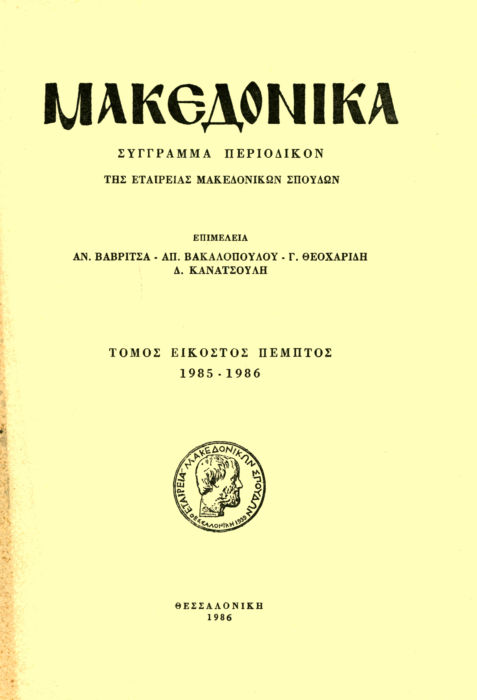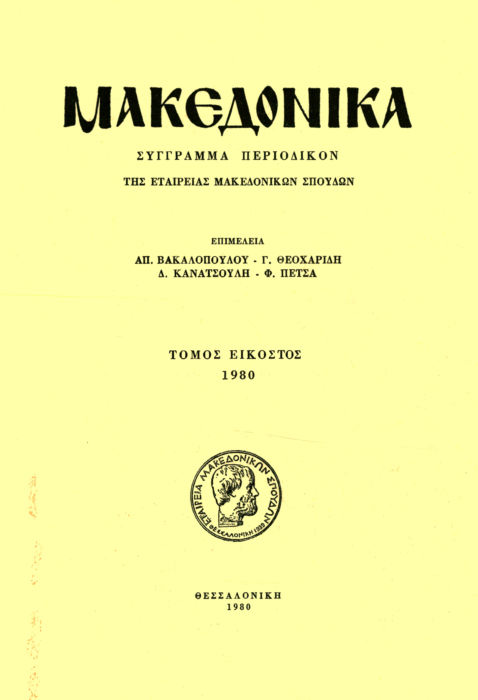Sirmium or Thessalonike?: a reexamination of a critical examination of the legend about St. Demetrius
Abstract
In a recent work (BZ, 67, 1974, 338-350) Michael Vickers of Oxford has taken up the old conjecture of E. Lucius (1904) and H. Delehaye (1909), that the worship of St. Demetrius of Thessalonike might have been transferred to Thessalonike from Sirmium, and has maintained: a) that the erection of St. Demetrius basilica at Thessalonike is connected with the withdrawal of the eparchy of Illyricum from the ruined Sirmium in the year 411 and that this erection, similarly as the erection of other palaeochristian monuments of the city, took place about the same time as the construction of the city walls by the (unwitnessed) eparch of Illyricum Hormisdas in the year 447 /8 and not by the soldier Hormisdas of the known wall-inscription in the year 380, b) that the founder according to the legend of the St. Demetrius basilica at Thessalonike, the eparch of Illyricum Leontius, is not the known Leontius of the Codex Theodosianus of 412/3, but another (unwitnessed) Leontius, who is known as eparch of the Orient in the year 434-435 and who conjecturally had served prieviously as eparch of Illyricum, c) that the legend in the Martyrologies of St. Demetrius has to be rejected, not only because it seems to ignore the existence of St. Demetrius remains, but also because no mention of a mar tyr named Demetrius is to be found in the most ancient Martyrology, the Hie- ronymian, whereas a diacon Demetrius, who suffered a martyrs death in Sir mium a 9th April, is mentioned in it, and d) that the eparch of Illyricum Leon tius, founder of a St. Demetrius basilica in Sirmium, having escaped to Thessalonike after the destruction of Sirmium in the year 411, brought along a «Engainion» and founded a St. Demetrius basilica in Thessalonike too. In this manner, he concludes, the worship of St. Demetrius has been transferred to Thessalonike after the decline of Sirmium and the very existence of a St. Demetrius of Thessalonike has been believed upon in the following centuries. Nevertheless, it can be shown, that the maintenances of M. Vickers are founded, all of them, upon unproved assumptions, while on the contrary facts have been disregarded, which prove the existence of a St. Demetrius worship in Thessalonike long before the destruction of Sirmium in the year 411.
These facts are the following: 1) St. Demetrius, who suffered a martyrs death under Galerius as emperor and after the fourth edict of Diocletian for persecution of Christians the 26th October 305, is a different person from the diacon Demetrius, who suffered a martyrs death under Galerius as caesar and after the thirth edict of Diocletian for persecution of Christians the 9th April 304. This, according to a fundamental rule of Hagiology, that the date and the place of martyrdom are the only safe criteria to discern one from the other two homonymous martyrs, and as a consequence of a St. Demetrius worship in both cities. 2) The absence of St. Demetrius of Thessalonike mentioned in the Hieronymian Martyrology proves nothing conclusively, considering that there are instances of saints, represented in mosaics, who are not mentioned in any known Martyrology, and considering too, that there is a logical explanation to the absence of mention of a St. Demetrius of Thessalonike in the Hieronymian Martyrology, which has been written in Italy. 3) The eparch of Illyricum, who retreated to Thessalonike after the destruction of Sirmium in the year 411, was not named Leontius but Apraeemius, as it is proved by the Novella XI of Justinian of the year 535. 4) The excavations during the archeological research of the years 1945-1949 in the burned down by the city conflagration of 1917 St. Demetrius basilica of Thessalonike have revealed the traces of an hellenistic three-aisled basilica, older than the basilica of the 5th century, and have proved consequently the existence of a St. Demetrius worship, older than the destruction of Sirmium in he year 411. 5) The iconographical tradition of the Saint too, representing him in his ancient mosaics and frescoes in a praying position (deisis), which is based on the prototypes of the cemeterial art of the Christians in the catacombs, points to a worship of the Saint, older than the 5th century and older than the destruction of Sir mium in the year 411. 6) An ancient idololatric worship of a Cabire discernably pushed aside by the St. Demetrius worship leads us to a time of its expansion before Theodosius the Great (379-395). 7) The posterior hagiological
fictions in the St. Demetrius Martyrologies can be explained by the political and religious antagonism between Sirmium and Thessalonike, which can be percieved in the history of Sirmium and in the existence of two traditions and two worships of a St. Demetrius, one in each city.
We may therefore discern, relying upon the more solid parts of the tradition and upon the unrefutable results of the archeological research, a) that the St. Demetrius worship has been transferred from nowhere, but has been grown up slowly in Thessalonike from the 4th century onwards, b) that the eparch of Illyricum Leontius of the Codex Theodosianus erected about 412/3 the first hellenistic three-aisled basilica upon the place of the primordial little Church-Martyrion of the Saint, c) that this first hellenistic three-aisled basilica of Leontius, burned down mostly during the only attested fire-brand of it in the year 635, has been rebuilded in short time as a five-aisled basilica «in the years of Leo», according to the known inscription, and has to-day a group of mosaics belonging to the three-aisled Leontius basilica of the 5th century and a group of mosaics belonging to the five-aisled Leo’s basilica of the 7th century.
Article Details
- How to Cite
-
Θεοχαρίδης Γ. Ι. (1976). Sirmium or Thessalonike?: a reexamination of a critical examination of the legend about St. Demetrius. Makedonika, 16(1), 269–308. https://doi.org/10.12681/makedonika.641
- Issue
- Vol. 16
- Section
- Articles

This work is licensed under a Creative Commons Attribution-NonCommercial-ShareAlike 4.0 International License.
Authors who publish with this journal agree to the following terms:
- Authors retain copyright and grant the journal right of first publication with the work simultaneously licensed under a Creative Commons Attribution Non-Commercial License that allows others to share the work with an acknowledgement of the work's authorship and initial publication in this journal.
- Authors are able to enter into separate, additional contractual arrangements for the non-exclusive distribution of the journal's published version of the work (e.g. post it to an institutional repository or publish it in a book), with an acknowledgement of its initial publication in this journal.
- Authors are permitted and encouraged to post their work online (preferably in institutional repositories or on their website) prior to and during the submission process, as it can lead to productive exchanges, as well as earlier and greater citation of published work (See The Effect of Open Access).









